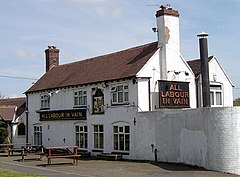Horsehay
This article has multiple issues. Please help improve it or discuss these issues on the talk page. (Learn how and when to remove these template messages)
|
| Horsehay | |
|---|---|
 The All Labour in Vain public house, Horsehay | |
Location within Shropshire | |
| Population | 4,292 (2011)[1] |
| OS grid reference | SJ675075 |
| Civil parish | |
| Unitary authority | |
| Ceremonial county | |
| Region | |
| Country | England |
| Sovereign state | United Kingdom |
| Post town | Telford |
| Postcode district | TF4 |
| Dialling code | 01952 |
| Police | West Mercia |
| Fire | Shropshire |
| Ambulance | West Midlands |
| UK Parliament | |
Horsehay is a suburban village on the western outskirts of
Horsehay used to have four pubs, The Station Inn, The Forester Arms, the All Labour In Vain and the Travellers Joy, however The Station Inn closed down in 2012, and the All Labour In Vain closed in 2014. It also has a Methodist Chapel, a village hall, a post office, and a golf course complete with restaurant.
Etymology
Its name is
History
Originally Horsehay was nothing more than a farm, until the 1750s when
Horsehay Works
This section needs expansion. You can help by adding to it. (September 2010) |
This section includes a list of general references, but it lacks sufficient corresponding inline citations. (December 2015) |
Horsehay works has a history of more than 230 years on the same site. Formed in 1755 by Abraham Darby II it contributed to the birth of the industrial revolution through large scale production of iron. Later it produced pre-fabricated bridges for export all over the world. It was a major employer in the area until the mid-1980s when it closed under the ownership of Adamson Alliance.
The following is based on an article "Horsehay Works (1755–1986) - a history of a once dominating company" by J. L. Woolley (local artist and former employee of Horsehay Works):
The new furnace ushered in a period of great activity when the East Shropshire Coalfield, for a time, became the area of greatest production of iron then known. Such was the importance of the furnace that many people including dignitaries visited it.
A railway from Horsehay to the nearby Severn wharves was built and the first waggon of 'pigs' (iron) was sent down Jiggers bank through Coalbrookdale and on to the wharves almost within sight of the Ironbridge (built later by Abraham Darby III, completed in 1779).
Telford Horsehay Steam Trust
Famous residents

Horsehay was the birthplace in 1913 of novelist
Back in the early 19th century, a giant of a man called William Ball worked in the Horsehay Iron Works. At the time, he was the heaviest man in England, tipping the scales at 36 Stones. Following an eye injury, he finished work at the Iron Works and toured the country under the name of "John Bull".
See also
References
- ^ "Civil Parish population 2011". Retrieved 27 November 2015.
- ISBN 0-7091-9340-8.
- Heath, P. Horsehay. Retrieved 20 October 2005.

